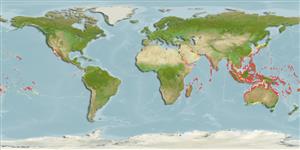Common names from other countries
Classification / Names / Names
Namen | Synonyme | Catalog of Fishes (gen., sp.) | ITIS | CoL | WoRMS
Environment: milieu / climate zone / depth range / distribution range
Ökologie
; tiefenbereich 0 - 30 m (Ref. 96667). Tropical
Indo-Pacific: French Polynesia to Japan, Australia and the Indo-Malayan region.
Length at first maturity / Size / Gewicht / Alter
Maturity: Lm ? range ? - ? cm Max length : 10.5 cm TL Männchen/unbestimmt; (Ref. 3148)
Sexual dimorphism, males have dark greenish coloration while females are whitish green.
Inhabits shallow water especially in upper intertidal zone (Ref. 3510, 80410) in reef flats and tidal flats under rocks and boulders or inside coral or rock crevices (Ref. 87055). Subtidal (Ref. 106854). It actively moves in between coral heads for prey (Ref. 80410).
Life cycle and mating behavior
Geschlechtsreife | Fortpflanzung | Ablaichen | Eier | Fecundity | Larven
Some members of the order Stomatopoda pair for life and some come together only to mate. Males produce sperm ducts rather than spermatophores; females can brood a maximum of 50,000 eggs. Life cycle: Eggs hatch to a planktonic zoea which lasts for 3 months.
Ahyong, S.T. 2001. (Ref. 3099)
IUCN Rote Liste Status (Ref. 130435)
CITES Status (Ref. 108899)
Not Evaluated
Not Evaluated
Bedrohung für Menschen
Harmless
Nutzung durch Menschen
| FishSource |
Tools
Internet Quellen
Estimates based on models
Preferred temperature
(Ref.
115969): 24.4 - 29.3, mean 28.3 (based on 3706 cells).
Verwundbarkeit
Low vulnerability (10 of 100).
